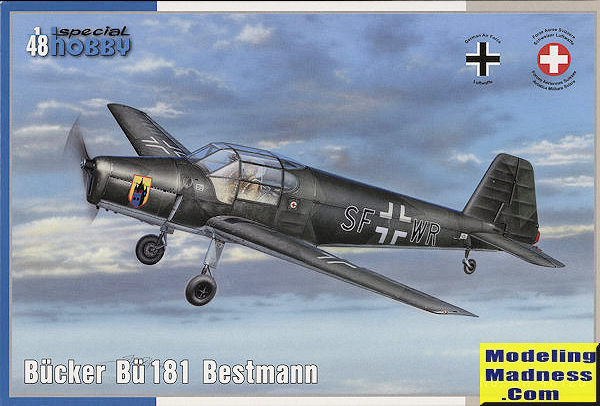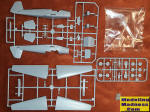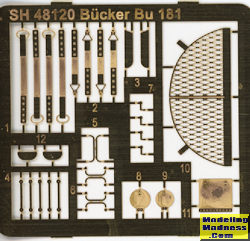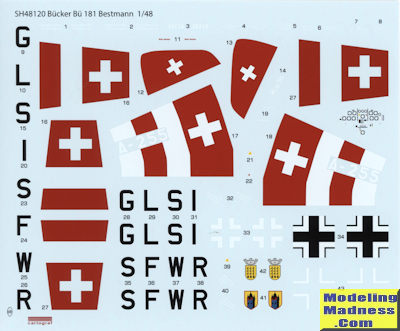
| KIT #: | 48120 |
| PRICE: | $22.00 plus shipping |
| DECALS: | Three options |
| REVIEWER: | Scott Van Aken |
| NOTES: | Short run with photo etch. |

| HISTORY |
The Bücker Bü 181 was named Bestmann after a German maritime term designating a member of the deck crew on coastal or fishing vessels. The prototype Bü 181 (D-ERBV) made its maiden flight in February 1939 with Chief Pilot Arthur Benitz at the controls. After thorough works and official flight testing by the Reichsluftfahrtministerium (RLM) the Bü 181 was nominated to be the standard primary trainer for the Luftwaffe. Series production of the Bü 181 commenced in 1940. The production types were designated B to C with only slight variations between each, and could be powered by the Hirth HM 500 A or B.
The Bü 181 aircraft was a single-engine low-wing monoplane with fixed undercarriage, split flap, twin controls and two adjustable seats arranged side-by-side. The cabin section of the fuselage was of a tubular steel frame construction whereas the rear of the fuselage had a wooden shell. The wing assembly and tail unit were also of wooden shell construction. All the rudders, elevators and ailerons had wooden ribs and are covered in fabric. The flaps were metallic on the B types and wood on the C types. The Bü 181 Bestmann was powered by a 105 hp four-cylinder Hirth HM 500A or B piston engine. The aircraft was designed for training flights, pleasure trips and aerobatics. Its strength corresponded to Stress Group 5 with a limited load (single occupancy) and Stress Group 4 fully laden.
A total of 3,400 Bestmanns were built over the years with production undertaken both during the war and post war in Germany, the Netherlands, Sweden, Czechoslovakia and Egypt. Movie-goers will recall that this was the aircraft used by James Garner and Donald Pleasance to attempt their get-away in the movie "The Great Escape". Interestingly, Pleasance was in the RAF and a POW during WWII but the director of the movie was not interested in any of his inputs!
| THE KIT |
 I
have always liked kits of trainers and have built quite a few over the
years. The Bu.181 has actually been rather well represented in terms of kits
and this is the latest one. It may even be a reboxing of someone else's kit,
but it looks like a standard Special Hobby tooling.
I
have always liked kits of trainers and have built quite a few over the
years. The Bu.181 has actually been rather well represented in terms of kits
and this is the latest one. It may even be a reboxing of someone else's kit,
but it looks like a standard Special Hobby tooling.
There are three grey sprues; one
with the wings and unused panzerfaust, one smaller sprue with several
wheel/landing gear options and unused skis, while the third sprue has
everything else and is the largest.
 A resin
bag contains what are separate exhaust stubs and a partial engine section so
you can have something to see when looking into the cowling intake. A clear
sprue makes up the rest. As is often the norm, there is a photo etch fret
containing things like the seat harness, the mesh screen for behind the
seats, rudd er pedal straps,
some instrument panel levers as well as interior and exterior grab handles
along with trim tabs.
A resin
bag contains what are separate exhaust stubs and a partial engine section so
you can have something to see when looking into the cowling intake. A clear
sprue makes up the rest. As is often the norm, there is a photo etch fret
containing things like the seat harness, the mesh screen for behind the
seats, rudd er pedal straps,
some instrument panel levers as well as interior and exterior grab handles
along with trim tabs.
Construction appears quite simple, taking up only three of the twelve pages in the instruction booklet. There is a decal to add to the instrument panel, which is nice. The interior contains side panels, rudder pedals and control sticks as well. The seats are bare of belts, but then you have these on the p.e. fret.
Wings are upper and lower halves on each side with the tailplanes being a single piece per side. The modeler will have to do some work on this one as the four exhaust pieces will need holes drilled for them. There is no marking as to where they go, which is also the situation with the tail gear, but the instructions provide distance measurements.
Cockpit clear bits are a full windscreen/canopy piece so you cannot pose it open without cutting. The rear quarter windows are molded into a fuselage section that fits behind this. There are two different wheel styles shown depending on which plane you are building. This is the only option shown. Actually, the landing gear leg piece shown for the Swiss option may be incorrect as photos of the extant plane in Switzerland's museum show different legs. Last steps are the installation of more photo etch bits and the prop.
 Instructions
are well done and in full color using Gunze paint references. There are
three full color pages of advertising and the three markings options. The
two German ones are in RLM 70/71/65 with yellow lower outer wings, while one
has a yellow fuselage band as well. The Swiss version has an upper surface
green that needs to be mixed with RLM 65 undersides. The nose will need to
be painted white, but all the other markings are provided as decals. Except
for the fuselage band, all the other areas that are red will need to be
painted white prior to applying the decal. Due to the rather straightforward
areas on which these are place, it should prove to be no issue, though I'm
sure some would have preferred having the option to paint all the stripes.
Decals are well done and should prove to be quite thin.
Instructions
are well done and in full color using Gunze paint references. There are
three full color pages of advertising and the three markings options. The
two German ones are in RLM 70/71/65 with yellow lower outer wings, while one
has a yellow fuselage band as well. The Swiss version has an upper surface
green that needs to be mixed with RLM 65 undersides. The nose will need to
be painted white, but all the other markings are provided as decals. Except
for the fuselage band, all the other areas that are red will need to be
painted white prior to applying the decal. Due to the rather straightforward
areas on which these are place, it should prove to be no issue, though I'm
sure some would have preferred having the option to paint all the stripes.
Decals are well done and should prove to be quite thin.
| CONCLUSIONS |
Overall a neat kit of an important war time and post war training aircraft that was also sold on the civilian market by Zlin after the war. I am not sure what is out there in terms of aftermarket, but I'm sure that there are other Special Hobby boxings to take care of the unused parts in this kit.
| REFERENCES |
https://en.wikipedia.org/wiki/B%C3%BCcker_B%C3%BC_181
September 2016
Copyright ModelingMadness.com. All rights reserved.
Thanks to me for endeavoring to locate this one so that you can be
well informed.
If you would like your product reviewed fairly and fairly quickly, please
contact
the editor or see other details in the
Note to
Contributors.